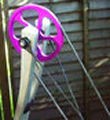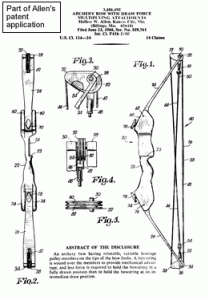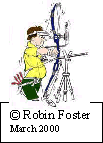The Bow with wheels
A Short History of the invention of the Compound Bow, by Robin Foster

Old Basing Archers embraces all disciplines of target archery and members may practice in which ever bow type most suits them. As a result, long-bow, recurve and compound toxopholites can all be seen on our shooting line. The English long-bow is well known to everybody; its proud tradition and glorious history has attracted many authors to produce well researched books on the subject. Long-bow archers also have their own organisation, the British Long-Bow Society, which caters specifically for their interest. The modern recurve weapon with its beginnings in the 1960s is the most widely shot bow and is well understood by most archers. The compound bow by comparison is still relatively mysterious to those who do not shoot it and little has been written about its origins and development. This article is a small attempt to rectify the situation.
From Bent Stick to Carbon Fibre
Since an unrecorded cave dweller, first discovered that he (or she!) could store energy by bending a stick with sinew tied to each end, archers down the ages have striven to improve the basic bow. At various times, these efforts have taken a significant step forward. The development of laminated limbs using horn and sinew by the Mongols, the use of heartwood and sapwood by the English bowyers, the application of rod and weight stabilisers by Earl Hoyt and Les Howis of Marksman Archery have all been mile-stones in the bows evolution. In more recent years, the use of high technology materials such as plastics, carbon fibre and kevlar have further added to the speed and accuracy of the bow.
Allen’s Landmark Invention
One of the really significant landmarks in the evolution of the bow took place in the USA in the early 1960s. At this time, the country was experiencing a surge of interest in the great out-doors and particularly bow hunting. With so many archers absorbed in this aspect of the sport, it was not surprising that a few of them should start experimenting to improve the efficiency of the basic bow. One of these experimenters was a mechanic from Missouri called Howless Wibur Allen. Early in 1961, he was inspired by the launch of the Hoyt Pro Medalist bow at their near-by factory. This was one of the first bows designed to be fitted with stabilisers. Allen thought that he

could further enhance the performance of the archery bow by using another ancient invention; the wheel. Allen’s brilliant idea was to harness the block and tackle principal of a pulley to a bow. In this way he reasoned that the mechanical advantage of the pulley should enable a heavier weight bow to be drawn. He created his first experimental bow by sawing off the limb tips of an old recurve and attaching small pulleys to it. Unfortunately the resulting bow had a very short draw-length as he had used conventional, centre axle pulleys. However, Allen did not give up and continued to experiment with different pulley systems. The most successful arrangements included cam shaped wheels and round pulleys with off-set axles called eccentrics. Both of these methods provided a more usable draw length but also resulted in an enormously beneficial side effect. The bow reached its peak weight at mid draw then reduced to a much lighter weight at full draw. This enabled Allen to comfortably hold at full draw, a heavy weight bow. When he tested these bows, Allen discovered that they had a really excellent cast and a surpassingly flat trajectory. After refined his new bow, H W Allen filed patent application number 3,486,495 on 23rd June 1966 for an “Archery bow with draw-force multiplying attachments”.
Early Set-Backs
Unfortunately, like so many inventors throughout time, Howless Allen’s pioneering innovation was certainly not an instant success. He visited every bow manufacturer across the USA, but could not convince anybody to make his new bow. This was principally because American State laws banned the use of mechanical devices for bow hunting and the various archery associations, such as the N.A.A., would not allow its use for field or target competitions. In spite of this, he was so sure that his new bow would prove popular, that he set up a bow manufacturing business himself. These early Allen bows had eccentric wheels rather than cams, as they were easier to manufacture and were more stable. However, they had a fundamental design flaw, as stripped fletchings were a constant hazard. This was due to the crossing cables at the middle of the bow obstructing the smooth path of the arrow. In 1967 Allen modified the design by adding an extra set of wheels mounted in the middle of each limb to create the 4 wheeler. These “idler” wheels were set at 90 degrees to the limb-tip eccentrics and meant the cables now crossed to one side of the centre line and arrow/cable clashes were eliminated. A further enhancement was the addition of riser mounted adjusters so that various cable lengths could be applied. As these were gear driven adjusters similar to guitar tuning pegs, it could be said that this was the start of real bow tuning!
Allen’s Bow Christened
The refined Allen bow was superb and highly efficient. The faster, flatter trajectory resulting from the increased stored energy meant that a heavy hunting arrow could be shot with greater speed with less chance of missing. In addition, the lighter holding weight at full draw meant that the bow was very comfortable to shoot. In spite of these benefits, the sport’s governing bodies still did not allow the bow. The big turning point for Allen came when he sent a sample bow to Tom Jennings, a famous American bowyer and the technical editor of “Archery World” magazine. Jennings thoroughly tested the bow and published the results in the May 1967 edition of the magazine. The title of Jenning’s article effectively christened the new bow and gave it the name by which it would be known in future. Jennings article was called “A Bow With Compound Interest”.
Jennings Success

Following the very favourable review, Jennings took one of Allen’s bows to a field course so that many archers could try it. Their enthusiasm for the compound bow convinced Jennings to take a big gamble. He stopped making recurve bows, took out a licence under the Allen patent, and concentrated all his efforts on the compound bow. There followed several years of hard work by both Allen and Jennings to persuade the United States licensing authorities and archery associations to lift the ban on the compound bow. When they eventually succeeded in February 1970, the market for the new bow expanded rapidly and almost over night about eight manufacturers were producing compound bows. Jennings made further improvements to Allen’s design by replacing the tuning key adjusters for the cables with pylons. These moved the cable terminations away from the riser towards the bow string and the resulting changed angle of the cable improved efficiency. His new model was called the “Arrowstar” and it remained a classic 4 wheeler target design from the mid 1970s to the mid 1980s.
Benefit of Wheels Explained

The compound bow is more efficient and stores more energy than an equivalent conventional recurve bow. This can be seen clearly when a graph is made of typical draw force against draw length for both types of bow. The area under each curve represents the amount of
energy stored. When the string was loosed on a compound bow, the arrow initially experienced a gentle force that rapidly increased as it accelerated. By comparison, the arrow of a recurve bow experiences a sudden, high force at the moment of loose which then diminishes as the arrow travels forward. This means that the arrow of the recurve must be stiffer and therefore heavier than arrow for an equivalent compound bow. Due to the string unrolling from the wheel, the limb-tips have a smaller distance to travel compared to a recurve bow. This means that more of the energy stored in the bow limb is available to propel the arrow.
The Compound Bow in Europe
It is not widely realised that the compound arrived on this side of the Atlantic as early as 1973. At this time, an English carpenter and joiner called Chris Jones was very active in IFAA field archery. While competing at the European Championships in Germany, Jones met an American serviceman who was shooting a Jennings compound. When the serviceman allowed Jones to shoot bow, he was immediately hooked and promised himself that he would buy one. Unfortunately, none of the British archery retailers were selling compounds then, so a friend who was due to visit the USA was requested to purchase a Jennings for him. The bow that the friend returned with was a PSE, but Jones quickly learnt to shoot it and started to win NFAS competitions. He also competed in target tournaments as a member of Archery GB, who were not as adaptable as the field societies and almost consigned him to a different field! Eventually he decided to have a go at making a compound himself and as the field archery community was particularly enthusiastic about the bow, he concluded that he might as well make ten. When these sold straight away, Jones could see the commercial possibility so set up Merlin bows in 1975. A few years latter when Mike Houghton, shooting a Merlin Bow, won the European Championship, the President of Jennings Bows invited Chris to be European Marketing Manager. This gave Chris the opportunity of working for Jennings in the USA for a few weeks and extending his knowledge. Today Merlin manufactures a complete range of bows and exports around the world. More recently other European manufacturers have turned their skills to the compound. In Belgium, the company of Green Horn has a long tradition of family bowyers. Although now owned and run by Artemis Archery Products, their Diamond Star compound bow has established an excellent high quality reputation. Mean while, back in Britain, the “Alternative” range of compounds has become available from the Internet archery shop, Alternative Sporting Services that is run by Tony Goodwin and serves archers around the world.
Continued Development


Through-out the 1970s, many different companies produced a variety of designs. Some of these were very complex and a few even bizarre in appearance. These unusual bows did not survive and the trend has been for the four wheel design to give way to two wheel models. These over-come the arrow clearance problems of Allen’s original design by using a cable guard to push the cables to oneside.The amount of cable off-set must be carefully set
to provide just sufficient clearance for the arrow but avoid wheel tilt or limb twist. As two wheelers use fewer components, they are more economical to manufacture and are also lighter in the hand. It is also interesting that they are very similar in appearance to the original Allen patented design. Another innovation is the single cam bow. To shoot at its most efficient, a compound must be adjusted so that the two cams or eccentrics both work exactly together, both reaching their peak weight at the same point in the draw length. The single cam bow simplifies this process by using just one cam on the lower limb and a conventional centre axle wheel on the top limb. As well as the wheels and cams, the limbs of the compound have been subject to development and change. Bows are available that feature split limb technology that uses limbs that are in two parts along their whole length. Although some people maintain that this design is liable to produce limb twist, Australian Clint Freeman holds the current FITA World Record of 1409 shooting this type of bow. The most recent development is the shoot through cable system which removes any possibility of wheel tilt and eliminates the cable guard altogether.
The Level Playing Field


Today the compound bow has come of age and has
established itself as an accepted discipline of our sport. It has been described as the first really new type of archery bow for hundreds of years and has truly created a level playing field for all archers. Due to its high efficiency and low holding weight, physical stature and strength is no longer an advantage. Ladies can compete on equal terms with men and the only reason for different scores is the skill of the archer shooting the bow.
British Successes
British compound target archers have established a formidable reputation on the international tournament circuit. At the 40th World Target Archery Championships in France in 1999, Stephen Gooden took the Silver Medal while the Mens Compound Team came home with the Bronze medal. At the last World Indoor Championships, which were held in Cuba, Jonathan Mynott took Silver and Simon Tarplee Bronze medal while Claire Trenaman took Bronze in the Ladies. In March 2000 the 7th European and Mediterranean Indoor Championships were held in Spała, Poland and once again, British compound archers achieved notable success. Britain triumphed in the Mens Team event taking the gold medal and Jonathan Mynott taking Individual Silver. In 1999, a survey of archers conducted over the Internet showed that 82% of the responders were in favour of its admittance as a separate class at the Olympic Games. This is currently under consideration by the WOC and FITA and the future for the bow with wheels looks very bright.

Acknowledgements
“Doctor Your Own Compound Bow” by Emery J Loiselle
“The Glade” magazine by E Bradford
The Archery Association
Twente University, Sagittarius Archery Club, Netherlands
Institut National Polytechnique de Grenoble
Alternative Sporting Services
Hoyt USA Bows Inc
Mathews Bows Inc
